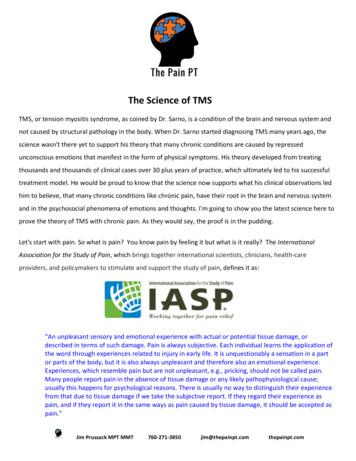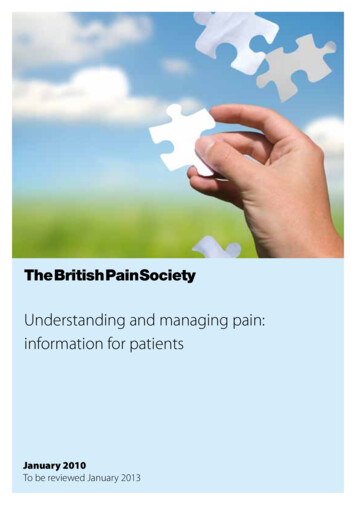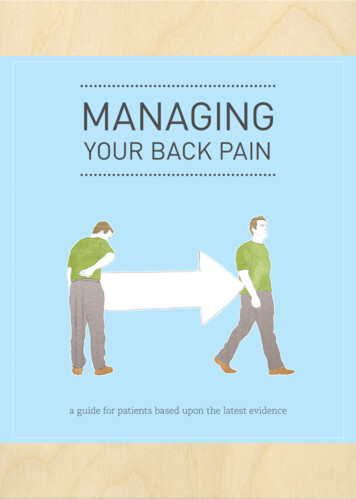
Transcription
The Science of TMSTMS, or tension myositis syndrome, as coined by Dr. Sarno, is a condition of the brain and nervous system andnot caused by structural pathology in the body. When Dr. Sarno started diagnosing TMS many years ago, thescience wasn't there yet to support his theory that many chronic conditions are caused by repressedunconscious emotions that manifest in the form of physical symptoms. His theory developed from treatingthousands and thousands of clinical cases over 30 plus years of practice, which ultimately led to his successfultreatment model. He would be proud to know that the science now supports what his clinical observations ledhim to believe, that many chronic conditions like chronic pain, have their root in the brain and nervous systemand in the psychosocial phenomena of emotions and thoughts. I'm going to show you the latest science here toprove the theory of TMS with chronic pain. As they would say, the proof is in the pudding.Let's start with pain. So what is pain? You know pain by feeling it but what is it really? The InternationalAssociation for the Study of Pain, which brings together international scientists, clinicians, health-careproviders, and policymakers to stimulate and support the study of pain, defines it as:“An unpleasant sensory and emotional experience with actual or potential tissue damage, ordescribed in terms of such damage. Pain is always subjective. Each individual learns the application ofthe word through experiences related to injury in early life. It is unquestionably a sensation in a partor parts of the body, but it is also always unpleasant and therefore also an emotional experience.Experiences, which resemble pain but are not unpleasant, e.g., pricking, should not be called pain.Many people report pain in the absence of tissue damage or any likely pathophysiological cause;usually this happens for psychological reasons. There is usually no way to distinguish their experiencefrom that due to tissue damage if we take the subjective report. If they regard their experience aspain, and if they report it in the same ways as pain caused by tissue damage, it should be accepted aspain.”Jim Prussack MPT MMT760-271-3850jim@thepainpt.comthepainpt.com
So pain is both a sensory and emotional experience, and can occur with a physical injury in the tissues orwithout an injury at all. If you can remember one thing, remember this: “pain is both an unpleasant sensoryand emotional experience.” This has been lost on most healthcare practitioners as many of them just focus onthe physical sensory aspect of pain and never ask any questions about the emotional side of pain. It would belike looking at only one side of a coin instead of looking at both sides. In fact, when it comes to chronic painthe emotional side of pain becomes more dominant than the sensory side. The sensory side of pain is typicallymore dominant in acute or subacute pain with physical trauma or injury. The thing is, the body heals frominjuries and most acute pain goes away with the passage of time. However there are a percentage of peoplewhere the pain persists beyond the body’s normal healing timeframe. For many years, researchers havehypothesized why this occurs and have inherently known psychosocial factors are involved with pain andother conditions. But now with the advent of new technology, scientists have been able to scan the brainversus just scanning the tissues of the body with x-rays and MRIs. The evidence coming out is showing that it isactually the changes in the brain and nervous system that predict and sustain pain, not the so-called abnormalx-ray and MRI findings that are mostly benign and age related.Brief Communication Published: 01 July 2012Corticostriatal functional connectivity predictstransition to chronic back pain Marwan N Baliki, Bogdan Petre, Souraya Torbey, Kristina M Herrmann, Lejian Huang, Thomas J Schnitzer, Howard L Fields& A Vania ApkarianNature Neuroscience volume15, pages1117–1119 (2012)Over the past 20 years, A.Vania Apkarian, who is a neuroscientist at Northwestern School of Medicine inChicago, has run many studies comparing the brains of patients with chronic back pain with those of healthypeople. He has found differences in brain anatomy and the function of certain regions of the brain with pain.His breakthrough brain imaging study came in 2012, where he was able to predict with 85% accuracy, yes IJim Prussack MPT MMT760-271-3850jim@thepainpt.comthepainpt.com
said 85% accuracy, who would develop chronic low back pain after an acute pain episode began. Apkarian andhis colleagues tracked the brains of back pain patients over time rather than comparing single neuralsnapshots. His team began with 39 people who had experienced moderate back pain—a five or six on a selfdescribed scale of 10—for 1 to 4 months. Over the next year, the team scanned the patients' brains four timesand followed their pain. By year's end, 20 of the patients had recovered, while 19 continued to hurt, meetingthe criteria for chronic pain.The scientists then looked at a number of brain characteristics, including the amount of communicationbetween two areas of the brain previously seen to have altered activity in back pain patients: the insula andthe nucleus accumbens. These regions are involved in emotional responses to a person's environment and inhow the brain learns. Not only did they measure more communication between these two areas in chronicback pain patients than in those whose pain subsided, but the increased crosstalk was seen as far back as thestart of the study. This is massive because it shows the emotional centers of the brain were overactive at thetime the pain started, which suggests it is the emotional factors which predict the continuation of pain, notphysical injury or the pain itself. This is exactly what Dr. Sarno says with his TMS diagnosis, that repressedunconscious emotions underlie chronic pain, not structural irregularities.The neuroscientist Apakarian, in relation to his ground-breaking study findings, states: "This is the very firsttime we can say that if we have two subjects who have the same type of injury for the same amount of time,we can predict who will become a chronic pain patient versus who will not. The injury by itself is not enoughto explain the ongoing pain. It has to do with the injury combined with the state of the brain.”J Dent Res. 2016 Jun; 95(6): 605–612.Published online 2016 Mar 10. doi: 10.1177/0022034516638027The Emotional Brain as a Predictor and Amplifier ofChronic PainE. Vachon-Presseau,1 M.V. Centeno,1 W. Ren,1 S.E. Berger,1 P. Tétreault,1 M. Ghantous,1 A. Baria,1 M.Farmer,1M.N. Baliki,1 T.J. Schnitzer,1 and A.V. Apkarian1Author information Copyright and License information DisclaimerSince that study, the science is continuing to come in, showing indeed it is the emotional brain that is apredictor and amplifier of chronic pain. In fact in 2016, Presseau wrote a research article titled exactly that,Jim Prussack MPT MMT760-271-3850jim@thepainpt.comthepainpt.com
“The emotional brain as a predictor and amplifier of chronic pain”. He states: “It should be noted that earlierclinical studies have identified a long list of risks for chronic pain, such as demographics, affective states,lifestyle, comorbidities, and others, yet collectively such parameters account for a relatively small amount ofvariance for chronic pain- about 10-20%. In contrast, the brain’s anatomic and functional properties predictthe development of chronic pain with 80-100% accuracy.” This is the same thing that Apakarian (2012)found in his brain study mentioned above. Eighty to 100% accuracy is a pretty strong finding if you ask me.The crazy thing is these findings are almost never put into clinical practice throughout the mainstreammedical community. If only we were able to take a brain scan of every patient instead of an x-ray or MRI, theworld might be different place when it comes to treating chronic pain disorders and other chronic problems.The good news is we don't need a brain scan of every patient, the scientific evidence is strong enough toback what Dr. Sarno clinically discovered and treated successfully a long time ago. That TMS, and notstructural anomalies, is responsible for chronic pain and other chronic issues.Presseau in his 2016 research article, goes on to say: “we hypothesize the persistence of pain is likelymediated through the reorganization of the cortex by cortico-limbic learning mechanisms. We posit thatchronic pain is a complex web of sensory and emotional experiences, coupled with behavioral adaptations.Specifically, we posit that the chronic pain state is a consequence of a change in value related to nociceptiveafferent information impinging on the cortex, with limbic emotional learning mechanisms underlying thisshift in value with little opportunity to extinguish these emotional memories.” In plain language, he is sayingthat emotional processes, not the sensory message of the pain, is what creates a chronic pain state. Hisconclusion is: “the fact that chronic pain seems to be critically dependent on the brain limbic propertiesexpands the general notion of pain, placing it within the proximity of negative emotions and negativeaffective states.” He goes on to say: “It seems we are on the cusp of a paradigm shift in concepts andmechanisms of chronic pain.” He is absolutely right about a paradigm shift, we just haven’t seen it yet inmainstream medicine. It takes a lot of time for research to translate into new clinical practice guidelines. Dr.Sarno was certainly ahead of his time, helping thousands of people overcome pain and other problems,while at the same time being maligned by his colleagues in the medical community because they thoughtwhat he was doing had no merit. Let’s add more merit to discussion here with another study.Jim Prussack MPT MMT760-271-3850jim@thepainpt.comthepainpt.com
REVIEW ARTICLEThe Relationship Between Structural and Functional BrainChanges and Altered Emotion and Cognition in ChronicLow Back Pain Brain ChangesA Systematic Review of MRI and fMRI StudiesSin Ki Ng, BBNSc (Hons),*† Donna M. Urquhart, B.Physio (Hons), PhD,† Paul B.Fitzgerald, MBBS, MPM, PhD, FRANZCP,*Flavia M. Cicuttini, MBBS, FRACP, PhD,†Sultana M. Hussain, MBBS, MPH,† and Bernadette M. Fitzgibbon, BA (Hons), MSc,PhD*The researcher Sin Ki Ng and colleagues published in the Clinical Journal of Pain in 2018 a systematic review ofMRI and fMRI studies of the brain in relation to chronic low back pain. What's great about a systematic reviewis that it looks at all the studies that have been done over the years and takes the best quality ones todetermine the most consistent findings across all the studies. The literature search yielded a total of 1003research papers. After the removal of duplicates, there were 715 unique articles remaining. After the firstphase of screening based on title and abstracts, 633 articles were excluded with a further 27 articles excludedwhen screened using full-text based on the inclusion criteria. During the second screening phase, articles wereexcluded if full-texts could not be found, or if they were conference abstracts. After the 2 screening phases, 55final papers were included.After reviewing all the brain MRI data in the 55 studies, the authors conclude: “this study has systematicallyreviewed the literature demonstrating that there are widespread structural and functional brain changes inindividuals with chronic back pain. The brain changes in chronic low back pain groups were mainly observedin areas and networks important in emotion and cognition, rather than those typically associated withnociception (sensory aspect of pain). This supports the understanding that emotional and cognitiveprocesses may be the core contributor to the chronic low back pain experience.”Jim Prussack MPT MMT760-271-3850jim@thepainpt.comthepainpt.com
So after narrowing down over 1000 studies to the 55 best ones, the conclusion is again, brain changes in thearea of emotion and cognition are what cause chronic pain and specifically chronic low back pain in thisexample. I can't state enough the powerful message from these studies demonstrating that it’s the brain andnervous system, not structural changes, which contribute to chronic pain and other chronic disorders. Weneed this evidence to repudiate the inaccurate messages people receive from their doctors or otherhealthcare providers. This supporting evidence, or knowledge as Dr. Sarno likes to call it, when accepted, iswhat leads to pain resolution. Dr. Sarno back in his day, had to convince people what he was saying was truewithout the evidence that we have here today. I believe his job would have been much easier if he had thedata that we have here now. Let’s look at another piece of evidence for TMS.SYSTEMATIC REVIEWBrain changes associated with cognitive andemotional factors in chronic pain: A systematicreviewA. Malfliet1,2,3,4, I. Coppieters2,4, P. Van Wilgen1,2,5, J. Kregel2,4, R. De Pauw4, M.Dolphens4, K. Ickmans1,2,31 Department of Physiotherapy, Human Physiology and Anatomy (KIMA), Faculty of Physical Education andPhysiotherapy, Vrije Universiteit Brussels, Belgium2 Pain in Motion International Research Group, Brussels, Belgium3Department of Physical Medicine and Physiotherapy, University Hospital Brussels, Belgium4 Department of Rehabilitation Sciences and Physiotherapy, Faculty of Medicine and Health Sciences, GhentUniversity, Belgium 5 Transcare, Transdisciplinary Pain Management Centre, Groningen, The NetherlandsThis study in the European Journal of Pain is another review of the literature and was completed in 2017 byMalfliet and his colleagues. The authors whittled down over a thousand studies to 28 studies that met thescientific criteria. Here’s the takeaway written conclusion by the authors: “This review shows thatmaladaptive cognitive and emotional factors are associated with several brain regions involved in chronicpain. Targeting these factors in these patients might normalize specific brain alterations.” It's interesting thatthey mention targeting these cognitive and emotional factors could normalize the brain. That's exactly whatwe do in the treatment of TMS, we treat the brain and nervous system not the structural tissues. It’s thepower of knowledge, combined with the right cognitive thoughts and the awareness of emotions, that leadsto a change in the brain, which causes a change in the pain.Jim Prussack MPT MMT760-271-3850jim@thepainpt.comthepainpt.com
Jim Prussack MPT MMT760-271-3850jim@thepainpt.comthepainpt.com
Another take away from this 2017 study is that the researchers found pain catastrophizing, which is negativethinking and beliefs around pain, may account for 47% of the variance in predicting the development ofchronic pain after an episode of acute pain. The authors state: “the key finding of this systematic review is thatthere is clear evidence that brain alterations, including gray matter volume, functional connectivity and restingstate network, and task-related brain activity, are undeniably associated with self-reported paincatastrophizing.” So negative thinking about pain changes the brain and not in a good way. That's why it's soimportant to send the right messages into your brain and nervous system that you are okay and not damaged.The reality is that you are not damaged with TMS, it's just that the brain may still think something’s wrong andreacts with negativity.Brain. 2013 Sep; 136(9): 2751–2768.Published online 2013 Aug 26. doi: 10.1093/brain/awt211Shape shifting pain: chronification of back pain shifts brainrepresentation from nociceptive to emotional circuitsJaveria A. Hashmi,1 Marwan N. Baliki,1 Lejian Huang,1 Alex T. Baria,1 Souraya Torbey,1 Kristina M.Hermann,1Thomas J. Schnitzer,2 and A. Vania Apkarian1,3,*I just want to throw out there some other research which adds further support that we need to look totreating the brain (TMS) and not the body when it comes to chronic pain and other chronic ailments. In 2013,the researcher Hashmi and colleagues found that the shift to chronic pain was related to the “strength offunctional connectivity between medial prefrontal cortex and nucleus accumbens determined at the time ofentry into the study.” This means people are predisposed to developing chronic pain based off what'shappening in their emotional and cognitive centers of the brain. He further states: “that predisposingcharacteristics of mesolimbic (emotional) circuitry at time of pain inception initiates a cascade of emotionallydriven learning events that effectually reorganize the brain into a chronic pain state.” So it's the emotionsagain, and how we perceive the pain that reorganizes the brain into a pain state.“For this is the great error of our day in the treatmentof the human body, that physicians separate the mindfrom the body.” –SocratesJim Prussack MPT MMT760-271-3850jim@thepainpt.comthepainpt.com
RESEARCH ARTICLEDistinct Brain Systems Mediate the Effects ofNociceptive Input and Self-Regulation on Pain Choong-Wan Woo, Mathieu Roy, Jason T. Buhle, Tor D. WagerAnother study in 2015 (Woo) led by Tor Wagner at University of Colorado found the same emotional brainregions that were active in Apkarian’s (2012) and Hashmi’s (2013) studies were also active in his studyvolunteers (nucleus accumbens, ventro-medial prefrontal cortex, etc). He suggests that in chronic painconditions, psychological pain overtakes physical pain as the main contributor to the overall sensation.Wagner found two distinct patterns in the brain with pain: one for the physical sensation of pain coming intothe brain, and another for the thoughts and emotions surrounding the physical sensation. This is in-line withthe definition of pain we looked at in the beginning: Pain is both a sensory and emotional experience. To getsome context, Ben Seymour, a neuroscientist at the University of Cambridge says: “Pain has always been a bitof a puzzle. Hearing or vision, for example, can be traced from sensory organs to distinct brain regions, butpain is more complex, and incorporates thoughts and emotions. For example, studies have linked depressionand anxiety to the development of pain conditions, and volunteers put in bad moods have a lower tolerancefor pain.” This all makes sense in light of the evidence we’ve learned today.Article OPEN Published: 10 January 2018Functional Brain Network Mechanism ofHypersensitivity in Chronic Pain UnCheol Lee, Minkyung Kim, KyoungEun Lee, Chelsea M. Kaplan, Daniel J. Clauw,Seunghwan Kim, George A. Mashour & Richard E. HarrisResearchers from the University of Michigan and Pohang University of Science and Technology in SouthKorea report new evidence of what is called explosive synchronization (ES) or abnormal sensitivity in thebrains of people with fibromyalgia, or widespread pain. The paper, published in Scientific Reports, in 2018,details only the second study of ES in human brain data. One of the authors Richard Harris, Ph.D., associateprofessor of anesthesiology at Michigan Medicine with the Chronic Pain and Fatigue Research Center, states:"For the first time, this research shows that the hypersensitivity experienced by chronic pain patients mayresult from hypersensitive brain networks." One of the other authors, UnCheol Lee, Ph.D., a physicist andJim Prussack MPT MMT760-271-3850jim@thepainpt.comthepainpt.com
assistant professor of anesthesiology at Michigan Medicine, says: "As opposed to the normal process ofgradually linking up different centers in the brain after a stimulus, chronic pain patients have conditions thatpredispose them to linking up in an abrupt, explosive manner.” This new science coming out is fascinatingand supports what we know from clinical practice, that many people suffering from chronic pain and otherchronic ailments are highly sensitive people.Pain. 2017 Oct;158(10):1979-1991. doi: 10.1097/j.pain.0000000000001001.Brain signature and functional impact of centralizedpain: a multidisciplinary approach to the study ofchronic pelvic pain (MAPP) network study.Kutch JJ1, Ichesco E, Hampson JP, Labus JS, Farmer MA, Martucci KT, Ness TJ, Deutsch G, ApkarianAV, Mackey SC, Klumpp DJ, Schaeffer AJ, Rodriguez LV, Kreder KJ, Buchwald D, Andriole GL, LaiHH, Mullins C, Kusek JW, Landis JR, Mayer EA, Clemens JQ, Clauw DJ, Harris RE; MAPP ResearchNetwork.The last study I want to present was published in the Journal Pain in 2017. The research team used data from1,079 participants from the Multidisciplinary Approach to the Study of Chronic Pelvic Pain Research Network(MAPP) study. The participants included questionnaires capturing their pain severity and function and werealso asked to draw on a body map where they were experiencing pain. Researchers then had a subset of theparticipants undergo functional and structural MRIs of the brain. The authors state: "Surprisingly, many of theindividuals, in addition to having pain located in the pelvic region, had pain also widely distributedthroughout their body. Interestingly, when we put these individuals into the brain imaging scanner, we foundthat those who had widespread pain had increased gray matter and brain connectivity within sensory andmotor cortical areas, when compared to pain-free controls.” These findings are similar to what we have seenin all the other studies and show it is the changes in the brain, and not in the body, that differentiate chronicpain from pain-free people.The authors then nailed the takeaway message from their results when they said: “We think that this type ofstudy will help treat these patients because if they have a central nerve biological component to theirdisorder, they're much more likely to benefit from targets that affect the central nervous system rather thanfrom treatments that are aimed at the pelvic region.” This is exactly what most of mainstream medicine doesJim Prussack MPT MMT760-271-3850jim@thepainpt.comthepainpt.com
not do. They are still treating the body instead of the brain. The evidence is clear we need to focus ourtreatment on the brain to have success in solving pain versus just managing it.All the data we have seen here indicates TMS originates in the brain and nervous system and that emotionsand thoughts underlie most chronic pain, not structural abnormalities. Because we are talking about thebrain and the nervous system, the answer to getting better is found in what Dr. Sarno says in his books. First,it is gaining the knowledge so you understand the causes of TMS. Understanding leads to confidence inaccepting the TMS diagnosis for yourself. Second, it is discovering what emotions you may be repressing,because these emotions cause your emotional brain to stay overactive or become hypersensitive, as wehave learned with the studies above. Third, it is sending the right messages into your brain and nervoussystem to say you are okay and nothing is wrong. Catastrophizing or negative thinking, as we have learned, issignificantly associated with brain changes and chronic pain.I hope this evidence gives you confidence in your diagnosis of TMS. The best news is that TMS is reversible.This is because the brain is plastic and can change. It’s called neuroplasticity. So let’s change your brain tochange your pain. Wishing you the best on your journey out of pain!Jim Prussack MPT MMT760-271-3850jim@thepainpt.comthepainpt.com
TMS, or tension myositis syndrome, as coined by Dr. Sarno, is a condition of the brain and nervous system and not caused by structural pathology in the body. When Dr. Sarno started diagnosing TMS many years ago, the science wasn't there yet to support his th










